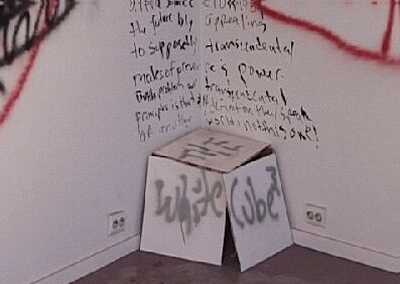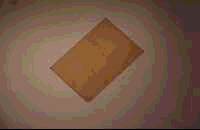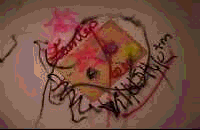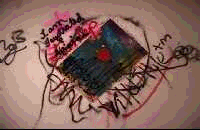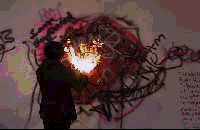The inside outside of the
White Cube
- A conversation with James Fuentes -
White Cube
- A conversation with James Fuentes -
‘The White Cube was a transitional device that attempted to bleach out the past and at the same time control the future by appealing to supposedly transcendental modes of presence and power. But the problem with transcendental principles is by definition they speak of another world, not this one.’
Thomas McEvilley 1986 in his introduction to Brian O´Dougherty´s ‘Inside the White Cube, The Ideology of the Gallery Space’ from 1977
Vanessa Black: James Fuentes you spent most of your
youth in the SouthBronx. Is it there where you learned to be a graffiti
artist?
James Fuentes: For my show at the Whitecube I chose to primarily use spraypaint.
And I did do a lot of writing on the walls but I just used the tools of
a graffiti artist. I am by no means a graffiti artist. Also, I would have
to say that my first introduction to graffiti was as a youth in the Lower
East Side of Manhattan. I lived across the street from the final
most important scene in 'Wild Style'. I was very young but I would
see graffiti on the handball courts that I played on, the subway cars
that I rode in and on every other conceivable write-able surface.
In the projects on the Lower East side I tagged in front of my cousin
once, she was visiting from Canada and I wanted to impress her... With
a pen I started writing on the front door of my building, I was really
embarrassed when she pointed out that fuck was spelled f-u-c-k not f-o-c-k.
Looking back I am even more embarrassed that I tried defacing my own building.
When I first moved to the South Bronx my neighbour asked me if I had a
tag. I wrote the first thing that came to my head and I found that I didnít
have a very skilled hand compared to him. Iím sure he practiced.
It just didnít interest me that much at the time. Although I had
places and maybe reason to practice graffiti it never worked out very
well.
VB: As far as I understand you are showing some of
these graffiti artists in a show you are curating right now.
JF: Yes, I am currently curating an exhibit called The South Bronx Story.The
graffiti component will include Crash, Del (an original member of theFantastic5),
Tatís Crew (mural artists), Chain 3 (of the Magnificent Team) & Stefan
Eins/One (the Viennese founder of the South Bronxís Fashion Moda) ifyou
can call him a graffiti artist.
VB: You grew up opposite Fashion Moda, did that create an interest in
art for you?
JF: Actually I grew up across the street from the Longwood Arts Project
which was founded in 1981 by Fred Wilson. It is also the place where Pepon
Osorio created and exhibited some of his signature pieces. Outside my
window I could see a John Ahearn Mural of two girls jumping rope called
'Double Dutch'. I canít say that this institution or these projects peeked
my interest in art because I actually learned about them about a year
after my family moved away from the neighbourhood. The fact that this
was all happening under my nose actually makes me yearn to re-visit it.
VB: Youíve had a gallery on Broome Street in SoHo where you exhibited
over three hundred artists within two years. Three hundred is that true?
JF: That number takes into account group shows, one of which included
close to two hundred photographers. For the very last show at Broome
Street I presented over forty solo shows in the last three months.
VB: Then you tried to move to Chelsea where you had
a financial breakdown while all the galleries around you flourished because
of the market boom. But now you have a free situation in the South Bronx,
in a temporary space. Does that mean that you are going back to your roots,
to your early experiences with art?
JF: I guess what I am trying to do is explore where I come from, which
happens to be an incredibly dynamic place with a rich past. I am learning
as much I can about this history and hopefully will make new history.
VB: I guess the people who live there created culture and history. I always
question when artists go to poor neighbourhoods to do projects as if to
fertilize their art with authenticity, or to play 'the other' for the
very concentrated mainstream market in New York.
JF: The Bronx is very inviting for project-oriented work and socially
engaged work which is different than the commercial ventures downtown.
It does offer an alternative to the Chelsea monopoly. In Europe it is
very common to travel to gallery spaces in the fringes. But what you must
realize is that even though the South Bronx is a twenty-minute drive from
Chelsea, psychologically it may as well be on another planet.
VB: I appreciate some of these efforts as long as they are not missionaries
play to the fact that art in a poor neighbourhood is better art.
JF: I can see how doing something like this can be exploitative, not everyone
is sincere with such efforts. But then there are people like Stefan Eins
who spent close to fifteen years developing a space in the South Bronx.
Fashion Moda made remarkable impact on its community and on the contemporary
art world. It is those people that I am focusing on. I am hyper-aware
of the potential for exploitation. But I am incapable of exploiting myself,
because the South Bronx is still essentially my own backyard.
VB: In the early 80s graffiti joined the alternative scene in the East
Village. Artists from poor neighbourhoods, joined hands with angry, yet
privileged young artists. In the beginning the East Village was a move
against the market then the market moved to the East Village and some
of the graffiti kids made it into blue chip galleries. This could be seen
as a political statement as if to put a tag on the fat belly of a banker.
But at that point I was not interested in Graffiti anymore. In the gallery
graffiti was an elegant piece on canvas that pretended to be art. That
stuff was sold, but not very successfully.
JF: I think the reason it wasnít very successful was
because a majority of the graffiti work being done was born in the public
realm and it didnít translate well into art for a gallery, the private
realm. It was this disparity that was the cause for contemporary arts
abandonment of graffitias art.
VB: I see myself producing for the public, not the private sphere. The
artsystem as we have it is still a distribution system for ideas, worldwide.
That some artifacts end up in the bedrooms of the rich comes after the
fact that the idea (that the object represents) was actually distributed
very well beforehand. But look. What you did here in the exhibition are
not nice graffiti pieces on canvas, it rather looks as if some kids just
sneaked in at night and messed with the WhiteCube. Like spraying some
private jokes on the wall or just nonsense that came in their heads. I
see this much more as an attack and a critique of the white cube. That
contrasts sharply with the display of nice spray paintings on canvas for
a hip wealthy audience or Ďpoliticalí murals as decor for the local grocery.
JF: I guess I am particularly at odds with the fetishizing of art objects
right now. The idea of editions for example, to make only three versions
of a picture (plus one artistís proof) so that no one else can buy it
and so it can command big money at an auction is a little bizarre to me.
The same way someone may try to inject importance into their work by working
in the SouthBronx, people try to make things more desirable by making
it more scarce. I think the art world thrives on inaccessibility.
But I donít have a problem with the WhiteCube, I actually do think its
an effective design for art viewing. But it shouldnít be the only one.
I was playing a little bit on the clean, minimalist shows youíve had recently.
What I made was messy.
VB: Well, no surprise, the WhiteCube is a critique of the Whitecube anyway.
But you not only spray-bombed the place; you made a painting as well.
How does that cope with affirmation and critique?
JF: I wanted to leave behind something for you to sell. I heard that WhiteCube
trades successfully the Gerhard Richter & Bernadette Corporation work,
so I thought to myself, 'I want the Whitecube to sell my stuff too!'
The original idea was to document myself painting a mural on your wall.
Instead I put a canvas in the middle of that mural so you can have a piece
of it.. The painting & the video will survive as mere relics of the
experience and be placed in a completely new context, either the
storage closet of your office or perhaps the walls of someone who reads
this.
VB: But it is a very ugly painting! I thought that
was the idea behind it that you paint it until it is dead...
JF: In my defense it was only the third painting I have ever made in mylife...
VB: Is that why you videotaped that rare event?
JF: After each gesture I made on the painting I videotaped ten seconds
of it. That means technically, that painting is over 100 paintings in
one. If someone really wanted one of those paintings that got 'lost' under
the other paintings we can reproduce one of those moments by enlarging
a video still. I offered everyone at the opening the opportunity to say
at which time-interval they felt I should have stopped painting. The video
is twenty-five minutes, on average people said I should have stopped painting
about three minutes into it. The final painting may be ugly but
the experience was beautiful.
VB: Yes, I agree, it is fun to watch the '...making of' a dead painting.
I always remember those stupid films that show us the genius in action.
I thought the fact that you filmed yourself was a critical statement towards
Picasso, Pollock or LŁperz performing for the filmmaker. So I thought
your video was not only 'The killing of a painting by painting' but also
'The killing of the Ďmise en sceneí of the hero painter'.
JF: Does that make me a hero?
VB: James Fuentes, we thank you for that conversation.
